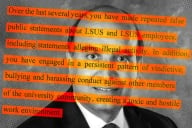You have /5 articles left.
Sign up for a free account or log in.
The best advertisements for printers in the history of advertisements for printers is HP’s web series The Wolf. Watch these two videos staring Christian Slater and you will be simultaneously: a) entertained, b) (somewhat) informed, and c) motivated to buy HP printers.
The first two productions follow Slater, channeling his Mr. Robot persona, using insecure printers to hack into a financial company and a health care record company. How awesome (or terrible) would it be if the third episode of The Wolf ends up being about a printer-based higher ed cyber attack?
Perhaps the IT security professionals in our IHE community can help illuminate the accuracy of the The Wolf, and the actual security risk that our printers represent. My first thought is that we have bigger IT security problems in higher ed than our printers, but I could be wrong.
The real lessons of The Wolf are not about IT security - they are about the changing nature of communications. Higher ed people don’t like to admit it, but marketing is a key to our business as it is to HP.
We are in constant competition to have our ideas gain traction in an environment where the supply of information is greater than the demand. We live in an attention economy, where the most important market is that for ideas.
This need for our message to rise above the noise transcends every aspect of the university. Academic status correlates with impact, meaning that superstar faculty status equates with being a successful entrepreneur of ideas.
In an environment of permanent scarcity, those campus projects and initiatives and priorities that will receive resources within an institution are those that can gain attention.
Colleges and universities operate within an extremely competitive environment for applicants, faculty, and funding. Developing and executing a messaging strategy on the differentiating strengths of our institutions is a non-negotiable strategic priority.
The trend that ties together all this need to communicate is video. Video is ascendant as the medium of choice for every aspect of communications.
High quality videos will be watched, and they will be shared. Video carries an emotional payload that is difficult to achieve with text.
The move away from computers and towards phones as our screen of choice as accelerated the primacy of video. Increasingly the information that we consume is consumed on a phone. The videos we watch are most often short videos. These videos then become sources of social media sharing and commentary.
Our communications challenge in higher ed will be learning how to navigate this new world of video-based messaging.
Quality video is expensive to produce. The people who are skilled at producing quality video are already hugely in demand on your campus.
If we want to get our messages out, then we will need to make videos. The problem is that everyone else wants to make videos. We will either need to improve our own media creation capacity, or get in line with everyone else.
Higher ed people are largely people of the book. The written word. I’m not sure that we are prepared for a future of video communications dominance. I know that I’m not.
How has your communications strategy changed with the shift from text to video?








